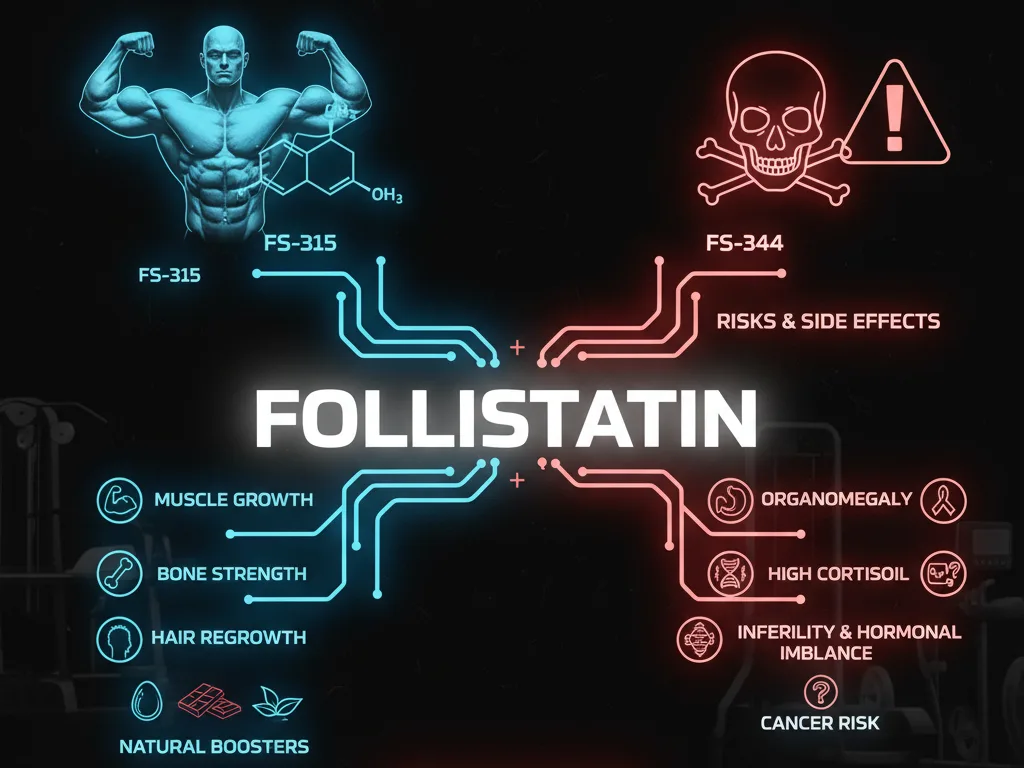Follistatin: The Muscle Growth Protein with Powerful Potential and Significant Risks
Follistatin is a fascinating glycoprotein (a protein with attached carbohydrate chains) primarily produced by folliculostellate (FS) cells in the anterior pituitary gland. Its name is derived from FSH (Follicle Stimulating Hormone), reflecting one of its earliest discovered functions: the inhibition of FSH. This particular action hints at one of the first potential side effects of follistatin use: reduced fertility. For this reason, if used in an athletic context, its timing is typically during a steroid cycle, not during PCT (Post Cycle Therapy), as it could worsen natural hormonal recovery.
Why Athletes are Drawn to Follistatin: Myostatin Inhibition
The primary allure of follistatin for athletes and bodybuilders lies in its ability to inhibit myostatin. Myostatin acts as a natural "brake" on muscle growth, limiting how large and strong muscles can become. When follistatin binds to myostatin, it essentially removes this brake, allowing for greater muscle hypertrophy (growth). This mechanism has earned follistatin the reputation of a "myostatin killer" in the pursuit of enhanced musculature.
Understanding the Different Types of Follistatin
Follistatin exists in various isoforms, each with potentially distinct functions:
FS-344: This is considered the most basic form and is predominantly used in gene therapy research. While often found in commercial products, it's generally considered less effective for direct muscle growth compared to other forms.
FS-315: This isoform is the main type found in the bloodstream and is believed to be the most effective for targeting muscle tissue, making it the most relevant for athletes.
FS-288: Primarily involved in reproductive health, FS-288 also plays a role in the development of tumors and cancer cells.
FS-300: This type is linked to reshaping nerve connections and has a role in cardiac inflammation.
Potential Benefits Under Research
Beyond its primary role in muscle growth, follistatin is being investigated for several other potential benefits:
Muscle Growth & Prevention of Muscle Loss: Its myostatin-inhibiting properties are central to these effects.
Hair Growth: Studies suggest it may increase hair thickness and density.
Cancer Treatment: Research is exploring its possible role in reducing the risk of certain cancers, such as those of the ovary, breast, and lung.
The Significant Risks and Side Effects
Despite its exciting potential, follistatin comes with a concerning profile of risks and side effects that cannot be overlooked:
Organomegaly: This refers to the abnormal enlargement of organs. Users may experience enlargement of the clitoris, stomach, intestines, heart, and other internal organs.
Hormonal Disruption: As a potent inhibitor, follistatin blocks the action of several important proteins and hormones, including FSH (impacting fertility), Growth Hormone (GH), and Growth Differentiation Factor 11 (GDF-11).
Cancer Risk: While it might reduce the risk of certain cancers, follistatin could potentially increase the risk or promote the progression of others, including prostate, stomach, skin, and gut cancers. This dual effect makes its use particularly dangerous regarding cancer development.
Cost and Practicality
Follistatin is an expensive compound, typically costing $250–400 per 1 mg. Common dosages range from 100–200 micrograms (mcg). From anecdotal experience, its real-world potency often falls short of the hype, particularly when compared to the effects of many traditional steroids.
Natural Ways to Influence Follistatin
For those interested in potentially influencing their follistatin levels without the severe risks associated with synthetic injections, some natural methods are suggested:
Fasted Training: Exercising in a fasted state may modestly increase follistatin.
Fertilized Egg Yolks: Consuming fertilized egg yolks is believed to contribute to follistatin levels.
Epicatechin-Rich Foods: Foods high in epicatechins, such as cacao powder, dark chocolate, green tea, blackberries, and raspberries, are thought to have a positive influence.
Hormonal Context: Glucagon is known to increase follistatin secretion, while insulin tends to inhibit it.
The Bottom Line
Follistatin presents an intriguing frontier in muscle growth, primarily due to its potent myostatin-inhibiting capabilities. However, its use is accompanied by serious and potentially life-threatening risks, including organ enlargement, infertility, and a complex, unpredictable impact on cancer development. Given its high cost, experimental nature, and often overstated real-world efficacy compared to the myths surrounding it, extreme caution is warranted. For those looking to optimize their physique, safer and more established methods, including natural boosts from diet and training (like those from egg yolks, dark chocolate, green tea, and fasted training), offer a path without the dangerous side effects of injected compounds.

